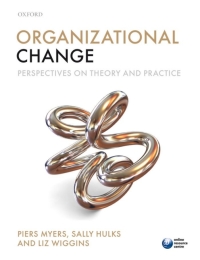O2 is a leading provider of broadband and mobile phones, based in the UK. It is part
Question:
O2 is a leading provider of broadband and mobile phones, based in the UK. It is part of the Telefonica O2 Europe group, operating across the UK, Ireland, Germany, the Czech Republic, and Slovakia. It was launched in 2001 following separation of the business from British Telecom and was acquired by Telefonica at the end of 2005.
Part of the company relaunch in 2001–02 was the creation of a new name and a new brand image.
Over the next two years, the brand became well recognized and its market share increased dramatically. To achieve this, a change programme was led from the top of the organization by the CEO for Europe, Peter Erskine, and the senior management team in the UK. There was some signifi cant restructuring of the business to achieve a rapid organization transformation, to throw off the British Telecom history, to remove ineffi ciencies, and to make clear in the market that O2 was gripping issues—that it meant business. In the fast-moving competitive market, senior managers felt that speed was of the essence and a directive approach was adopted to effect the changes. By the summer of 2005, there were disputes over pay and job losses, and further redundancies. Strikes were just avoided after several months of negotiations between senior managers and unions.
At this point in 2005, the UK CEO, Matthew Key, decided that, alongside expansion, he wanted to focus on rewarding customer loyalty and increasing customer retention, by improving the service provided in shops and call centres, where behaviour was driven by sales targets and effi ciency metrics;
there was a need to re-establish the idea of relationship with the customer. A change programme of a different nature was instigated, adopting a facilitated approach, to get employees’ input into how to change the customer experience. Key wanted also to unlock people’s pride and passion in working for a big brand name, which is what O2 had become.
This change programme was based on experimentation and conversation. At local level, managers and staff were encouraged to experiment with different day-to-day ways of working to create a more empowered culture. There was ‘permission’ to break some of the rules that got in the way of serving the customer well. This became known as ‘positive deviancy’. Different parties were brought together to develop relationships and to share practice across the business. The purpose was to adopt where possible the best of existing practice, rather than to force people to adopt one central model, or, conversely, to allow dozens of different initiatives without everyone getting the benefi t.
The formal aspect of this change programme used the Appreciative Inquiry (AI) method, with a summit designed around the theme of a ‘better place’ attended by a cross-section of 300 employees.
By the end of day three, some thirty employee-led projects had been launched, including: the creation of a ‘shadow board’ of employees, accepted by the board as part of its decision-making process, to ensure that ‘the customer experience sat at the heart of all business decisions’; an environmental project to improve waste recycling rates; an inquiry process that offered some 1,000 employees the opportunity to input their view of the sort of place they wanted O2 to be. Matthew Key said: ‘We (the O2 Board) were making a leap of faith, but this (was) real people engagement and we could see that’ (Vanstone, 2007: 7).
As a result of the many suggestions, call centres handlers started to provide an end-to-end service, rather than hand over to others. Retail outlets were twinned with call centres to forge better relationships and understanding.
It is diffi cult to make direct connections between the initiative and profi ts. However, customer retention and customer satisfaction surveys improved between 2005 and 2006. Within the organization, every directorate recorded improvement in the employee engagement survey in 2006 and O2 was listed for the fi rst time in the ‘Best Place to Work’ league tables.
Questions 1. Thinking back to Chapter 9, what part did a directed approach take in O2’s change? Do you think this was an appropriate approach when it was adopted and, if so, why?
2. Against the backdrop of redundancies and threatened strikes, how might the change in approach in 2005 have been experienced?
3. To what extent do you think the changes that came about as a result of the summit were deep seated or cosmetic, and why?
4. Had you entered O2 as the organization development (OD) practitioner in 2005, how would you have gone about the diagnosis? What other interventions could assist the change?
5. What do your refl ections tell you about working with a range of approaches to change?
Step by Step Answer:

Organizational Change Perspectives On Theory And Practice
ISBN: 9780199573783,9780191512902
1st Edition
Authors: Piers Myers; Sally Hulks; Liz Wiggins





